Listen:
Check out all episodes on the My Favorite Mistake main page.
My guest for Episode #319 of the My Favorite Mistake podcast is Sapna Pieroux, award-winning author of Let’s Get Visible!, a branding consultant, and the founder of Inner Visions ID.
With a background spanning 20 years in media and experience working with major brands like Toyota, Sony, and L’Oréal, Sapna shares the defining mistake that led her to a new level of impact: believing that her great work alone would speak for itself. Early in her entrepreneurial journey, she hid behind a company logo and resisted putting herself out there—fearing criticism, judgment, and even considering a pseudonym for her book.
In this honest and inspiring conversation, Sapna shares how she overcame those fears and the societal pressures—especially those that affect women and people of color—to stay small or silent. Through her own evolution, she discovered the power of personal branding and visibility, not just for business growth but for personal confidence. She now helps leaders and teams align their business and personal brands so they can show up with clarity, confidence, and credibility in a noisy world.
We also explore common branding mistakes—like trying to DIY logos without strategy—and how Sapna’s signature “Do-Say-See” model helps entrepreneurs and professionals build trust and influence. Whether you're just starting out or trying to get unstuck, Sapna’s insights on visibility, imposter syndrome, and brand alignment will give you practical tools and thoughtful encouragement.
Questions and Topics:
- Is branding more about how others see you—like a nickname—than what you say about yourself?
- What was your favorite mistake?
- How was hiding behind your logo hurting your business?
- How close were you to publishing your book under a pseudonym?
- Was your publisher encouraging you to publish under your real name?
- What do you now teach others about personal branding as a result of that mistake?
- Why do you think many women hesitate to talk about their accomplishments?
- How did red become such a key part of your brand?
- What are some early steps someone can take to build their personal brand if they’re nervous about putting themselves out there?
- What gave you more confidence to show up consistently?
- How did entering awards help you boost your visibility and credibility?
Scroll down to find:
- Video version of the episode
- How to subscribe
- Quotes
- Full transcript
Find Sapna on social media:
Video of the Episode:
Quotes:
Click on an image for a larger view
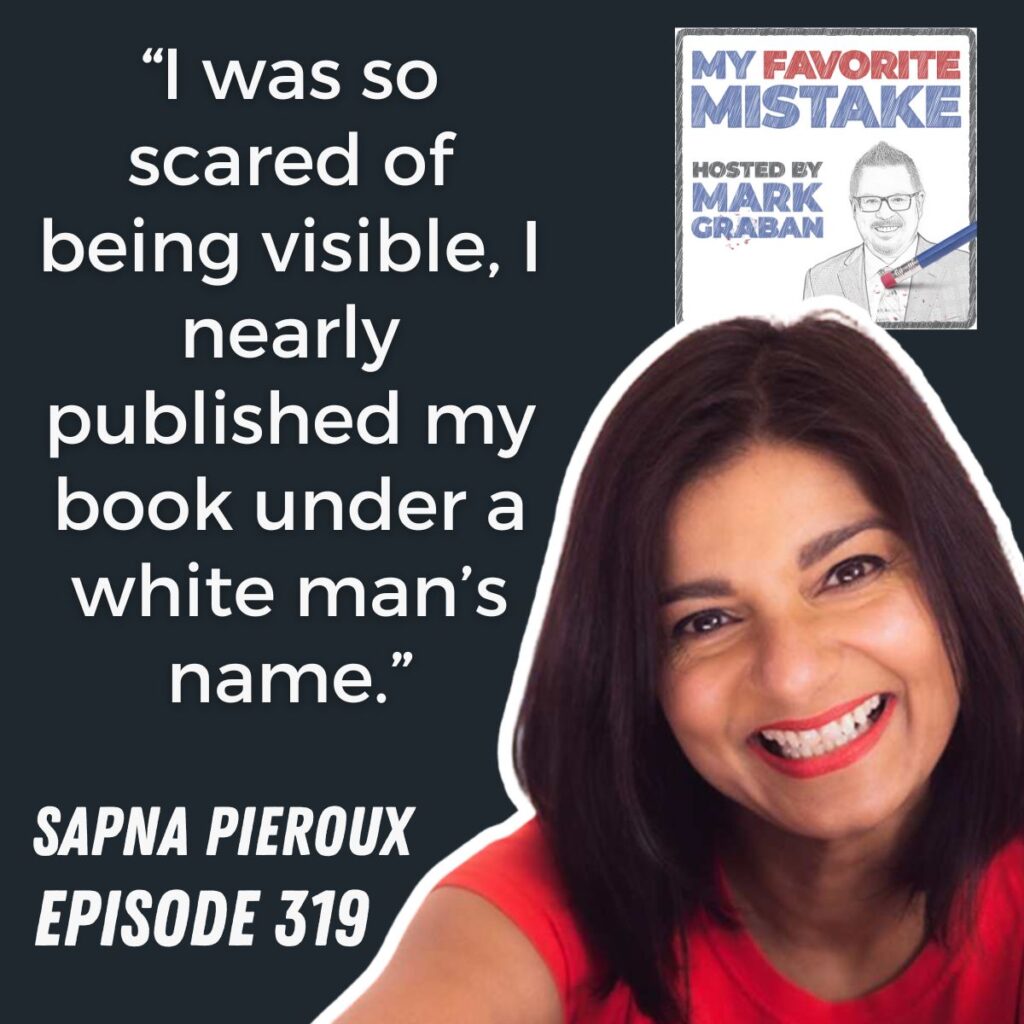
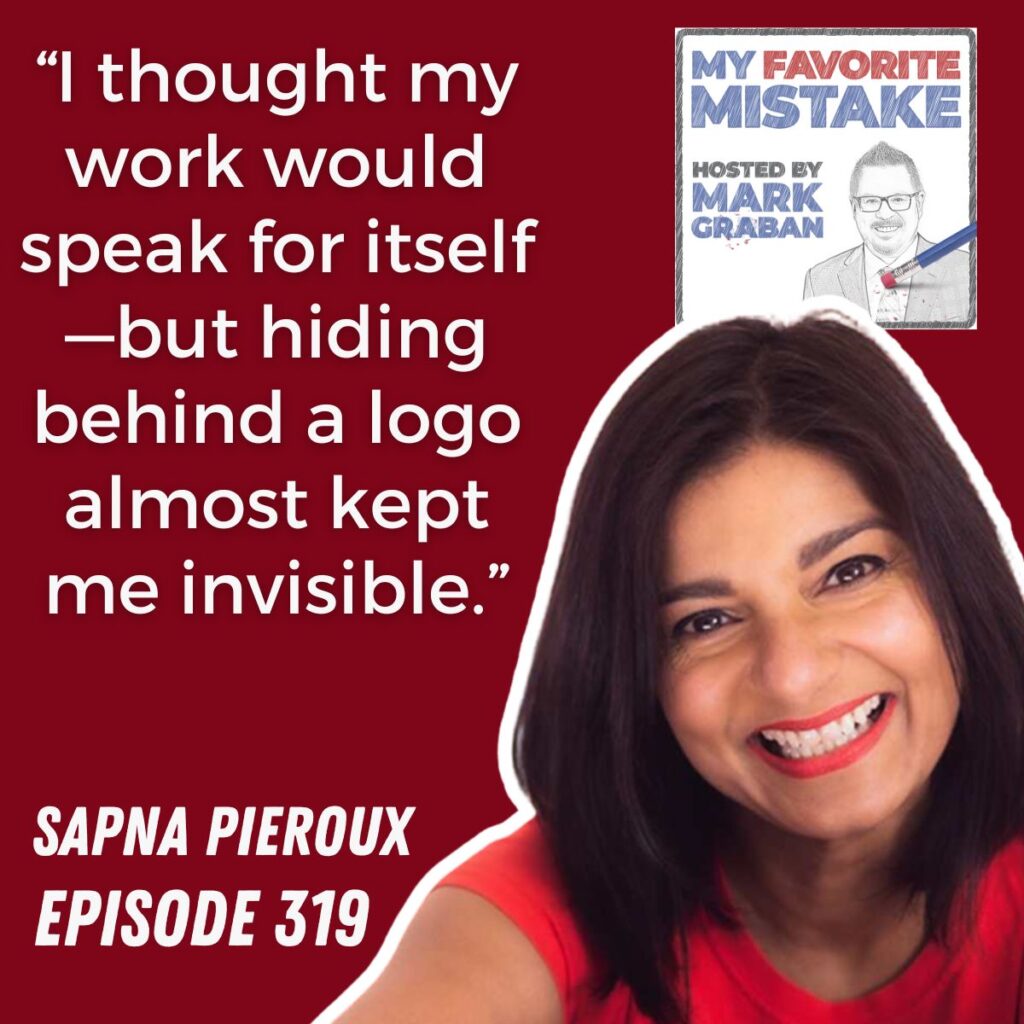
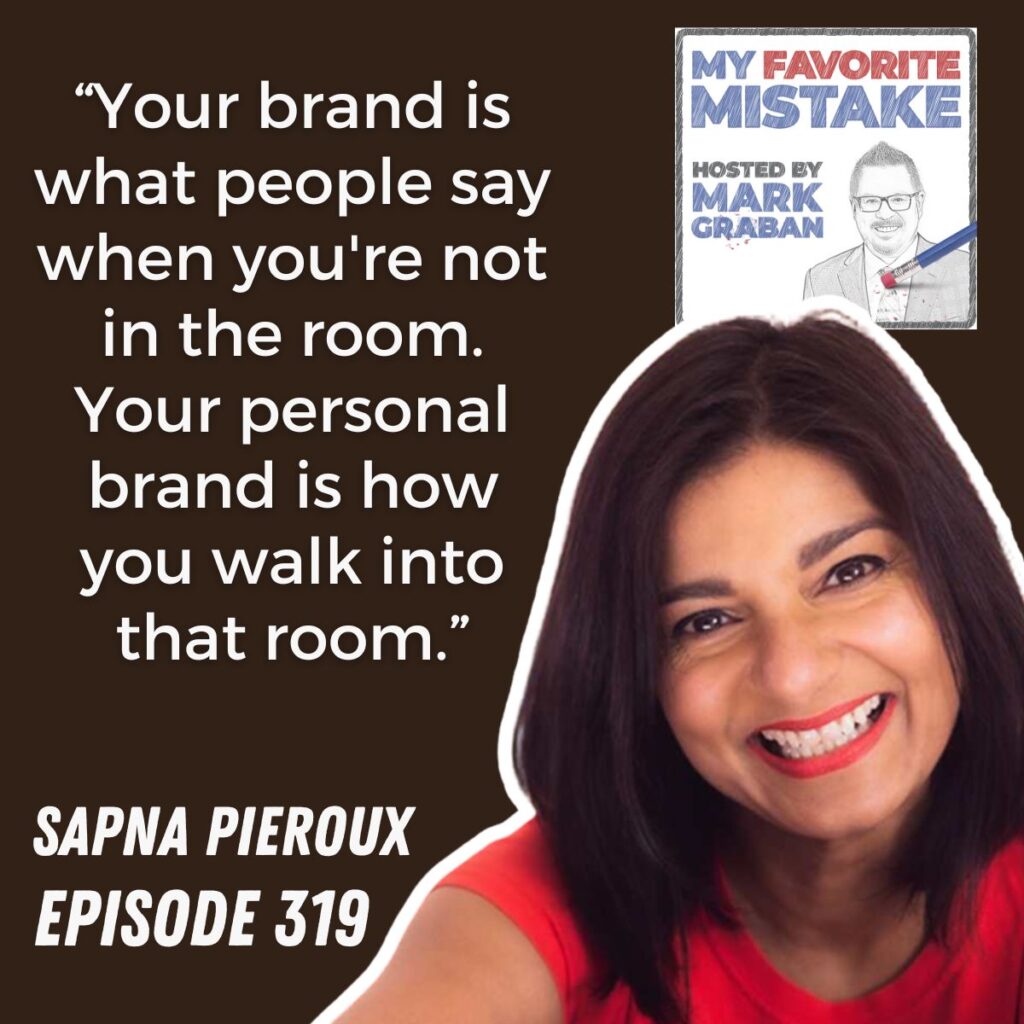
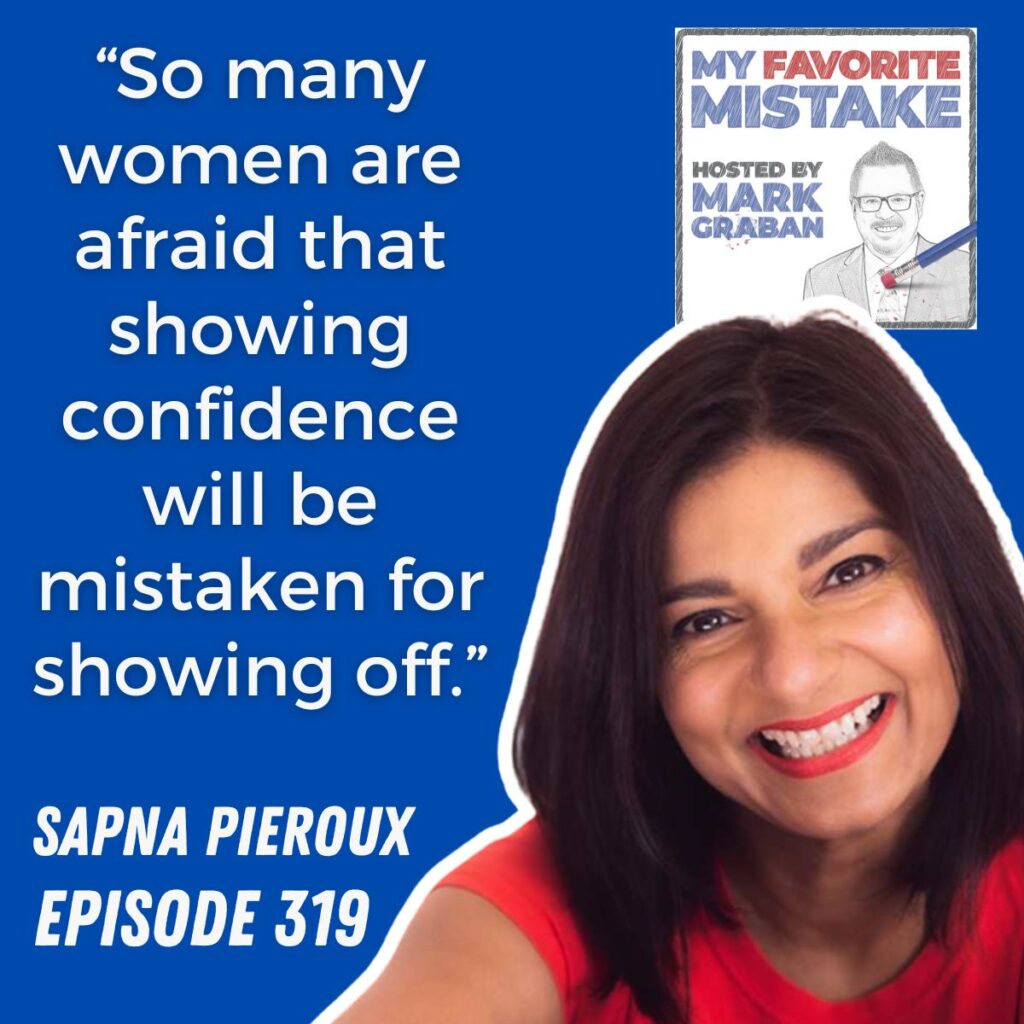
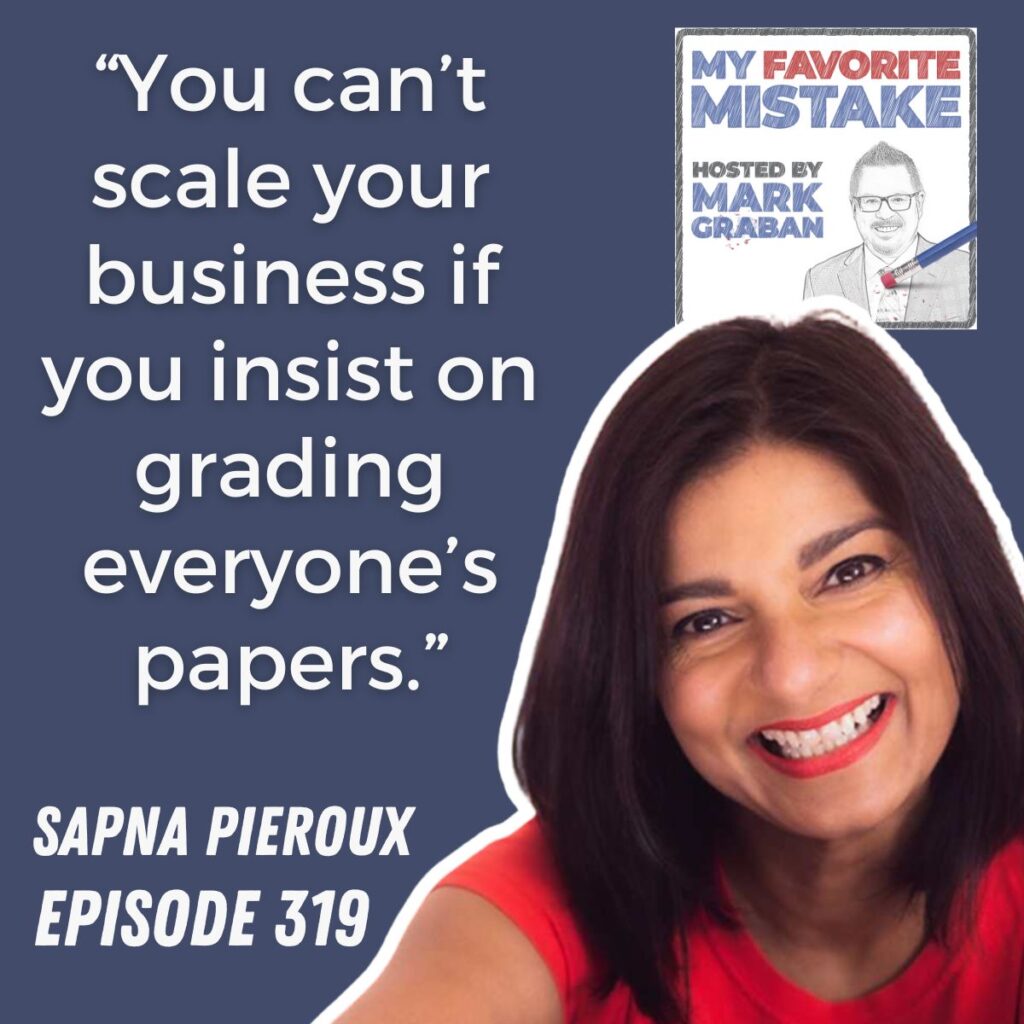
Subscribe, Follow, Support, Rate, and Review!
Please follow, rate, and review via Apple Podcasts, Podchaser, or your favorite app—that helps others find this content, and you'll be sure to get future episodes as they are released.
Don't miss an episode! You can sign up to receive new episodes via email.
This podcast is part of the Lean Communicators network.

Other Ways to Subscribe or Follow — Apps & Email
Automated Transcript (May Contain Mistakes)
Mark Graban:
Hi, welcome to My Favorite Mistake. I'm your host, Mark Graban. Our guest today is Sapna Pieroux. She's a consultant, author, and expert speaker. She's been building brands for nearly 30 years. For her first 20 years in media, she worked with clients including Toyota, Sony, Ericsson, and—L’Oréal.
After having children, she started her own brand consultancy, Inner Visions ID, building personal and business brands for ambitious leaders and teams so they can stand out and show up with clarity and confidence—to increase their influence and impact. Sapna's bestselling book is titled Let’s Get Visible! with an exclamation point. Those of you on YouTube can see that over her shoulder. Let’s Get Visible! won a Global Business Book Award for startup inspiration.
So Sapna, thank you for being here today. How are you?
Sapna Pieroux:
Thank you so much for having me. I'm good, I'm good. I’ve been looking forward to this chat. We had to reschedule, didn’t we?
Mark Graban:
Yeah, that happens. I’m glad we can finally be together here to record. I’ve got to ask real quick though, so—you’re wearing a Superman logo? Superwoman? Supergirl?
Sapna Pieroux:
They do! One of my superpowers—it's a moniker my clients gave me—is that I can rebrand businesses in a day using my Vision process, which is in the book. It kind of happened by accident. Red is my brand color. The book came out—it was red—and I had lots of red dresses for speaking gigs.
When the book launched in 2019 and 2020, I was speaking at events, and then lockdown hit. Suddenly, my message Let’s Get Visible felt ironic because we were all hiding away. I couldn’t wear those posh red dresses on Zoom while homeschooling and feeding the kids 15,000 snacks a day.
So I thought, what have I got that’s red? I found a Wonder Woman T-shirt left over from my son’s superhero-themed birthday party. I pulled it on, and people loved it. So now I’ve got a whole range of superhero T-shirts—Supergirl, Superwoman, The Flash, Wonder Woman—and I lean into the “S” because people call me “Super Saps.”
Mark Graban:
Is it fair to say—before we get to the “favorite mistake” question—when it comes to branding, is it more about what others see in you? Sort of like a nickname—what they think your brand is, is what counts?
Sapna Pieroux:
Oh, do you know what? I’ve never been asked that, and I’ve never thought about it that way. But certainly… well, I actually say that your branding is something you're in control of. Your brand is the experience that other people have of you.
So it’s a combination of the two. You build a brand by giving others the experience. Back in the Mad Men era—yes, we’re currently re-watching Mad Men because we love Jon Hamm—brands were built top-down. The ad men told you what to think through posters, radio, and TV.
Nowadays, brands are built from the ground up—user experience. Think about it: when you’re buying anything significant, you check the reviews. You don’t just trust the ad campaign. So now, it’s about happy clients and real stories. The branding needs to match the level of service.
If your product is great, but your website loads slowly or is full of typos, or the brochure looks dated—or the founder has spinach in their teeth or halitosis!—then the brand experience falls short. It doesn’t align with the quality you say you provide.
Mark Graban:
Great intro to brand and branding. We'll come back to this later, especially branding mistakes. But let’s jump in—what’s your favorite mistake?
Sapna Pieroux:
It’s the mistake that probably defined my career now. My favorite mistake—or my biggest mistake—when starting my business was believing, hoping, praying that my wonderful work would speak for itself. That I could hide behind the work and the logo.
I’d spent 20 years in corporate working with big national and global brands. The brand was bigger than me—I was a cog in a machine. A happy cog! I loved what I did. But standing out personally wasn’t part of the job.
So when I started my entrepreneurial journey, I created a logo and wanted to sound like a bigger company. That’s a legit tactic—especially when you're trying to work with corporates and you need that business credibility. As I expanded my team, it worked. They had team emails and sign-offs, but still—I was hiding.
I was hiding behind the brand. Talking about “we.” Scared to put myself out there. And that was the mistake.
Sapna Pieroux:
Especially in entrepreneurship—and now, in any industry—the personal brand has come to the forefront. People buy from people. That started with folks like Steve Jobs and Richard Branson, who were bigger personalities than the brand. They figured it out long ago. But the rest of the world is catching up.
Think about it: if I say “Tesla,” you know who the slightly bonkers leader is—Elon Musk. But if I say “Jaguar,” do we know who runs that brand? We don’t. So it’s a fairly modern phenomenon, this rise of the personal brand. But ultimately, people buy people.
So my big mistake was staying hidden—too scared to come out. Like a lot of creatives, I preferred to do the work. I’m very happy in the work. That’s the thing I’m actually very talented at. But talking about the work is harder—less so now that I’ve had more practice, have a story to tell, and a book to promote.
But I was so scared of getting visible, I nearly used a pseudonym for my book. That would have been a mistake.
Mark Graban:
How close were you to doing that?
Sapna Pieroux:
I was in tears on the phone to my publisher. I said, “Why the hell am I doing this?” I was terrified. My name—Sapna is Indian, it means “dream.” Pieroux is Belgian, my husband’s name. So I have this very foreign-sounding name, and there’s research showing that if your name is short and easy to say, you do better in life.
Mark Graban:
Steve Jobs, Richard Branson, Elon Musk—all short names.
Sapna Pieroux:
Exactly! And I named my sons Luke and Leon so they wouldn’t have to constantly spell their names. Naming matters in branding, too.
I had also read that women’s business books don’t perform as well. They’re reviewed more harshly, sell for less, and aren’t taken as seriously. So I had come to the logical conclusion: to help my book do well, maybe I should put a white man’s name on the cover.
Mark Graban:
Was your publisher encouraging that? Were they giving you that advice?
Sapna Pieroux:
No, no. Lucy McCarraher from Rethink Press—she’s amazing. If it weren’t for her, I wouldn’t have written or published the book. She wrote A Book of One’s Own—or “ABOO,” as she calls it—as a rallying cry for women to write their business books and have their voices heard.
She also founded the Business Book Awards. The first year, 12 winners—all white men. 30% of entries were from women. So that told her something: there’s unconscious bias here. She decided to take action.
She encouraged me to write Let’s Get Visible. I was the one saying I should use a white man’s name. She asked, “How will you be a key person of influence if your name isn’t on the cover?” That hit home. I wasn’t writing the book for ego—I wrote it to help people. But Lucy helped me see that if I want to grow my business and brand, I have to own it.
Mark Graban:
So what kept you from using a pseudonym?
Sapna Pieroux:
Honestly, Lucy. Her encouragement. And the realization that this book needed to be mine. Today, I’m proud of it. It won an award. It’s helped people. And it passed very stringent judging. So yeah—I’m owning it now.
Mark Graban:
That’s great. So, a story of avoiding a mistake, which is just as powerful. Did you ever consider something like “Sir Richard James with Sapna Pieroux”?
Sapna Pieroux:
Ha! No, never thought of that. But that happens a lot, right? When someone says “with so-and-so,” usually that’s the ghostwriter. But in this case, I am the writer, and I’m proud of that now.
Mark Graban:
Well, congrats on all of it. I want to dig a bit deeper into your story—especially how you moved past the fear, because that ties directly into what you help others with.
And I’ll share—your story resonates with me. I’m an engineer. I like doing the work. But I’m still not great at sales and lead generation. Like you said, “The work should speak for itself,” but it just doesn’t.
Sapna Pieroux:
Exactly! And now that’s what I help people with. Because your work can be stolen, copied, plagiarized. That happened to me. Someone came into my business, stole my methodology, and shared it with clients. That was awful.
But what they can’t steal is you—your essence, your personality, your voice. People work with you because they trust you. And your work doesn’t have a voice of its own. But you do.
Many women, especially, struggle to talk about how brilliant they are. We’re conditioned from a young age—“Don’t show off,” “Be a good girl,” “Be quiet.” Quiet kids are seen as good kids. That carries into adulthood and the workplace, where we don’t speak up or we get talked over.
Sapna Pieroux:
There’s this great mashup word I saw recently—it was a blend of plagiarism and testosterone—but I can’t remember it exactly. Anyway, it referred to when a man repeats something a woman just said in a meeting and gets credit for it: “Great idea, Bob!” And you’re like, “I literally just said that.”
There’s a whole thing about women struggling to speak up about their achievements without feeling like they’re bragging or fearing judgment—often from other women. There’s a woman I follow on LinkedIn, Sophie Lee, and she said something that really struck me: phrases like “She’s so full of herself” or “She loves herself”—those are said to tear women down. But think about it—what’s the alternative? Should we be half full of ourselves? Should we hate ourselves?
Mark Graban:
Right, and that double standard is so obvious. I’ve heard expressions like, “If I could only have the confidence of a mediocre white man.”
Sapna Pieroux:
I’m glad you said it! But yes. I’m married to one—and he’s lovely, by the way. We’ve got two mixed-race sons. And when I had boys, I thought, wow, their lives are going to be easier just by virtue of being male. That’s not the only thing that matters, of course, but it’s a real head start.
I gave them simple, easy-to-pronounce names—Luke and Leon—that will travel well globally. My husband, Andy, even says to them, “If you say something confidently, people will believe you—even if you don’t know what you’re talking about.” And my son actually said, “Daddy told me that.” I thought, well, okay, that’s one approach.
Mark Graban:
And confidently saying that you should say things confidently… that’s a whole other layer of confidence.
Sapna Pieroux:
Exactly! So now I help clients build their personal brands too. I’ve realized everything I do—personal or business brand—is really about equity. I help the smaller players look credible enough to play in the big leagues.
When they look the part, they feel more confident. People have more trust in them. Branding is like dressing your business for the future you want. What do you do for a job interview? You dress for it. Same with branding.
Mark Graban:
So what’s one of the biggest branding mistakes you see?
Sapna Pieroux:
Trying to do it on the cheap. People go to Fiverr or get their friend with a Mac to design a logo. Or one client told me her mother amended her logo. You can imagine how that turned out.
They try to save money on the one thing that’s supposed to attract people to their business. That’s a mistake. I use my “Do-Say-See” model to help clients. Everything you do, everything you say, and everything people see about your brand should align like a three-legged stool.
Most people start with the “Do”—what am I going to do to make money? What services or products? Then they move to “Say”—how do I tell people about it? Social media, website, email, maybe a podcast. But “See” is last—and it’s often rushed.
That’s when they slap together a logo without any strategy. Then they wonder why they don’t feel confident promoting it. It’s because the visual identity isn’t grounded in the brand’s deeper meaning.
Mark Graban:
Sounds like the mistake is trying to piecemeal it instead of taking a holistic approach—like an architect would when designing a house.
Sapna Pieroux:
Exactly. Choosing your logo before building your foundation is like picking wallpaper for a house you haven’t built yet.
Sapna Pieroux:
I’ve worked client-side and agency-side. I studied design, then postgrad marketing. I spent years in media—radio, where there are no visuals. So I learned to understand branding from a 360-degree perspective. It’s not just how your brand looks, it’s how it feels, how it communicates, and how it shows up across everything you do.
And the same applies to personal brands. People often tell me, “I don’t want to put myself out there,” but being visible doesn’t mean sharing every messy detail of your life. You don’t have to air your neuroses or chaos. It’s a curated version of your professional self. It’s about showing people what it would be like to work with you. Are you fun? Authoritative? Reliable?
I try to be both fun and authoritative. I want to make branding feel playful but also strategic and serious. It’s about balance. Your business brand should speak when you’re not in the room, and your personal brand should align when you walk into the room.
Mark Graban:
That red dress or red superhero tee—people see you before you’ve even spoken.
Sapna Pieroux:
Exactly. I’ve had people say, “I looked around the room and didn’t see a red dress, so I knew you weren’t there.” I’m being noticed in rooms I’m not even in. That’s visibility.
Mark Graban:
So how did red become such a key part of your brand? It’s not just a color for you.
Sapna Pieroux:
No, it’s very intentional. When I started my business in 2016, I’d been a stay-at-home mum for three years. I had postnatal depression. I didn’t like my body. I wore black to hide the dirt, the chaos, the weight. Ninety percent of my wardrobe was black or grey.
When I started speaking in 2018, I had a black dress I thought looked chic. But when I watched the video, I blended into the audience. I looked like a floating head. That’s when I realized why speakers wear color.
I hired a stylist—another mum from school. She helped me build a “speaker wardrobe.” I had my colors done. Turns out I’m a cool winter—so jewel tones like red, emerald, cobalt blue. I started experimenting.
The book cover for Let’s Get Visible! is red—because I wanted it to stand out on a shelf or in a feed. Then another friend, Emily, said, “Why aren’t you wearing red on stage? It’s your brand color.” So I leaned in. Bought five or six red dresses. Then lockdown happened—and I switched to red superhero T-shirts for Zoom talks. It all came together organically.
Mark Graban:
If someone’s struggling with putting themselves out there, do you recommend small steps? Maybe writing posts instead of doing video? Or is it better to take a big leap?
Sapna Pieroux:
That’s such a good question. I can only speak from experience—but it’s something I help clients with too. I started small. I was terrified of video. So I created a private Facebook group and started doing Lives every Wednesday. Not to the whole world—just a small group of friendly faces.
I also invited guests into the Lives. It’s always easier for me to have a conversation than to monologue. And having that consistency—showing up every week—helped. It wasn’t polished or perfect, but it got me visible.
Another big mistake people make? Jumping into brand photography or design without understanding what their brand stands for. They say, “I just want logos, colors, and fonts—I don’t need all that brand strategy.” But that’s like choosing wallpaper for a house with no foundation.
Sapna Pieroux:
What really helped build my confidence—besides doing regular Facebook Lives—was getting my colors done. Honestly, knowing what suits you has a massive psychological effect. That shirt you're wearing, Mark—it brings out the blue in your eyes. I don’t know if you realize that.
Mark Graban:
I did not realize that! People listening to the podcast can’t see it, but thank you.
Sapna Pieroux:
You’re blushing a bit—there’s your red!
But seriously, investing in little things like getting your hair done, or having clothes that fit and flatter, can shift your energy. So many women I work with have gotten so used to being invisible, they’ve stopped making an effort—and then they feel self-conscious about being seen. Especially if they’ve gained weight, aged, or just don’t feel camera-ready. But people care more about what you say than what you look like.
I follow someone named Samantha Harman. She’s not your typical stylist—she says clothes are a manifestation of your future success. If your wardrobe elevates you, it changes how you show up. She has this free guide called Just Get Dressed. She says, “If you can’t even be bothered to show up for yourself, how do you expect others to believe in you?” And that really stuck with me.
So now, even if I’m just working from home, I might still wear red heels. Even if I’ve got my superhero T-shirt on, I’ve got kick-ass shoes under the desk. Why not? The energy is different.
Mark Graban:
That’s such a powerful reframe—showing up for yourself. So beyond wardrobe and videos, what else helped build your visibility?
Sapna Pieroux:
I started speaking at smaller events, and worked my way up to bigger stages. I also entered awards. That was a big deal. Winning my first award gave me a huge confidence boost.
In 2019, I won a local business networking award. That gave me the courage to go for a national one—I won bronze for Businesswoman of the Year in the UK. Then came the Global Business Book Award. I didn’t start there—I built up to it. Each win made me feel more seen, more legitimate.
And yes, visibility brings vulnerability. But you can manage how much of yourself you put out there. You don’t have to share your deepest insecurities. Just enough for people to understand who you are and how you work. That’s the essence of personal branding.
Sapna Pieroux:
So when I work with clients on their personal brand, it’s about clarity first. Who are you? What do you want to be known for? What’s your “north star”—what would you want people to say about you at your funeral? Start there. Build your brand from that place.
And then, yes, your wardrobe, your photos, your website—those all become expressions of that core identity. But if you start with the visuals without that clarity, you’re just creating noise.
On the business brand side, it's the same. People come to me and say, “I just need a logo,” and I say, “Well, no—you need the meaning behind the logo.” Otherwise, it's like building a house without a blueprint. I work holistically. We look at your mission, values, personality, customer journey, and then we translate that into a strong brand identity.
Mark Graban:
What I hear is that people want to rush to the output, but they skip the input—the strategy, the reflection.
Sapna Pieroux:
Exactly. Strategy gives confidence. Confidence leads to visibility. Visibility leads to impact.
That’s what Let’s Get Visible is all about. If your brand isn’t visible, you’re losing out on opportunities. People scroll past you, they forget you. You have to stand out. And standing out doesn’t mean being loud or flashy. It means being clear, consistent, and aligned.
Mark Graban:
And thank you for sharing that message, and for being so open about your own fears, struggles, and what you’ve learned. I think a lot of people will relate—myself included.
The book again is Let’s Get Visible: Get Brand Clarity, Stand Out in Your Industry and Supercharge Your Business. It’s available in paperback, Kindle, and audiobook. And if people want to connect with you?
Sapna Pieroux:
Yes—connect with me on LinkedIn and say you heard me on this podcast, and I’ll send you a free PDF copy of the book. I just want to get it into people’s hands. It’s not about sales—it’s about impact.
Mark Graban:
That’s really generous. And I’ll include links to your website, LinkedIn, and more in the show notes. I’ve learned a lot from you today. I’m inspired to rethink how I’m showing up—and maybe share my own books more freely.
Sapna Pieroux:
Thank you so much for having me, Mark. This has been such a meaningful conversation.
Mark Graban:
And thank you again for being here, Sapna, and for being not just visible—but heard.

